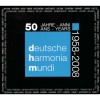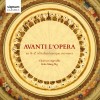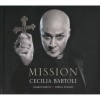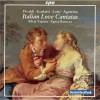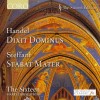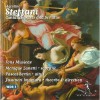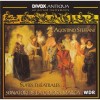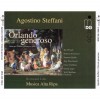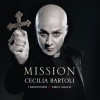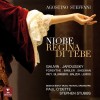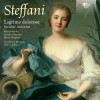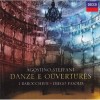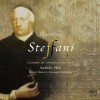Biography
Agostino Steffani (25 July 1654 – 12 February 1728) was an Italian ecclesiastic, diplomat and composer.
Steffani was born at Castelfranco Veneto. At a very early age he was admitted as a chorister at San Marco, Venice. In 1667 the beauty of his voice attracted the attention of Count Georg Ignaz von Tattenbach, by whom he was taken to Munich, where his education was completed at the expense of Ferdinand Maria, Elector of Bavaria, who appointed him Churfürstlicher Kammer- und Hofmusikus and granted him a liberal salary. After receiving instruction from Johann Kaspar Kerll, in whose charge he lived, he was sent in 1673 to study in Rome, where Ercole Bernabei was his master, and among other works he composed six motets, the original manuscripts of which are now in the Fitzwilliam Museum at Cambridge.
On his return to Munich in 1674 he published his first work, Psalmodia vespertina, a part of which was reprinted in Giovanni Battista Martini's Saggio di contrappunto in 1774. In 1675 he was appointed court organist. The date when he was ordained priest, with the title of Abbate of Lepsing, is not precisely known. His ecclesiastical status did not prevent him from turning his attention to the stage, for which, at different periods of his life, he composed work which undoubtedly exercised a potent influence upon the dramatic music of the period. Of his first opera, Marco Aurelio, written for the carnival and produced at Munich in 1681, the only copy known to exist is a manuscript score preserved in the royal library at Buckingham Palace. It was followed by Solone in 1685, by Audacia e rispetto, Prerogative d'amore and Servio Tullio in 1686, by Alarico in 1687, and by Niobe, regina di Tebe in 1688.
Notwithstanding the favor shown to him by the Elector Maximilian Emanuel, he accepted in 1688 the appointment of Kapellmeister at the court of Hanover, where he speedily improved an acquaintance dating from 1681 with Ernest Augustus, Duke of Brunswick-Luneburg (Celle; afterwards Elector of Hanover), winning also a pleasant footing with the Elector's daughter Sophia Charlotte (afterwards Electress of Brandenburg and Queen of Prussia), the philosopher Leibniz, the Abbate Ortensio Mauro, and many men of letters and intelligence, and where, in 1710, he showed great kindness to Handel, who was then just entering upon his glorious career. He inaugurated a long series of triumphs in Hanover by composing, for the opening of the new opera house in 1689, an opera called Enrico il Leone, which was produced with extraordinary splendour and achieved an immense reputation. For the same theatre be composed La Lolta d'Ercole con Achilleo in 1689, La Superbia d'Alessandro in 1690, Orlando generoso in 1691, Le Rivali concordi in 1692, La Liberia contenta in 1693, I Trionfi del Job and I Baccanali in 1695, and Briseide in 1696. The libretto of Briseide is by Palmieri. Those of most, if not all the others are by the Abbate Mauro.
The scores are preserved at Buckingham Palace, where, in company with five volumes of songs and three of duets, they form part of the collection brought to England by the Elector of Hanover in 1714, when ascending as King George I of Great Britain. But it was not only as a musician that Steffani distinguished himself in his new home. The elevation of Ernest Augustus to the electorate in 1692 led to difficulties, for the arrangement of which it was necessary that an ambassador should visit the various German courts, armed with a considerable amount of diplomatic power.
The accomplished abbate was sent on this delicate mission in 1696, with the title of envoy extraordinary, and he fulfilled his difficult task so well that Pope Innocent XI, in recognition of certain privileges he had secured for the Hanoverian Catholics, consecrated him bishop of Spiga in the Spanish West Indies. Between 1709 and 1723 Steffani served as Vicar Apostolic of Upper and Lower Saxony, a new Roman Catholic diaspora jurisdiction, embracing Upper and Lower Saxon territories.
In 1698 he was sent as ambassador to Brussels, and after the death of Ernest Augustus in the same year he entered the service of the Elector Palatine, John William, at Düsseldorf, where he held the offices of privy councillor and protonotary of the Holy See. Invested with these high honours, Steffani could scarcely continue to produce dramatic compositions in public without grievous breach of etiquette. But his genius was too importunate to submit to repression; and in 1709 be ingeniously avoided the difficulty by producing two new operas: Enea at Hanover and Tassilone at Düsseldorf in the name of his secretary and amanuensis Gregorio Piva, whose signature is attached to the scores preserved at Buckingham Palace. Another score, that of Arminio in the same collection, dated Düsseldorf, 1707, and evidently the work of Steffani, bears no composer's name.
Steffani did not accompany the elector George to England; but in 1724 the Academy of Antient Musick in London elected him its honorary president for life; and in return for the compliment he sent the association a magnificent Stabat Mater, for six voices and orchestra, and three fine madrigals. The manuscripts of these are still in existence, and the British Museum possesses a very fine Confitebor, for three voices and orchestra, of about the same period. All these compositions are very much in advance of the age in which they were written; and in his operas Steffani shows an appreciation of the demands of the stage very remarkable indeed at a period at which the musical drama was gradually approaching the character of a merely formal concert, with scenery and dresses. But for the manuscripts at Buckingham Palace these operas would be utterly unknown; but Steffani will never cease to be remembered by his beautiful chamber duets, which, like those of his contemporary Carlo Maria Clari (1669–1745), are chiefly written in the form of cantatas for two voices, accompanied by a figured bass. The British Museum (Add. MSS. 5055 seq.) possesses more than a hundred of these charming compositions, some of which were published at Munich in 1679. Steffani visited Italy for the last time in 1727, in which year Handel, who always gratefully remembered the kindness he had received from him at Hanover, once more met him at the palace of Cardinal Ottoboni in Rome. This was the last time the two composers were destined to meet. Steffani returned soon afterwards to Hanover, and died on 12 February 1728 while engaged in the transaction of some diplomatic business at Frankfurt.
Steffani stands somewhat apart from contemporary Italian composers (e.g., Alessandro Scarlatti) in his mastery of instrumental forms. His opera overtures, etc., show a remarkable combination of Italian suavity with a logical conciseness of construction which is due to French influence. In vocal music he is considered inferior to Scarlatti, and none of his famous duets, despite their charm, can compare for seriousness of intention with the Sicilian master's chamber-cantatas with the exception of Avanti il levar de la tenda (See external references below) which is superior in melodic construction and is a precursor to Mozart's work for voice. His instrumental music, however, is historically important as a factor in the artistic development of Handel.







